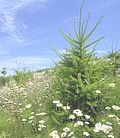Reforestation
Reforestation is the natural or intentional restocking of existing forests and woodlands that have been depleted, usually through deforestation. Reforestation can be used to rectify or improve the quality of human life by soaking up pollution and dust from the air, rebuild natural habitats and ecosystems, mitigate global warming since forests facilitate biosequestration of atmospheric carbon dioxide, and harvest for resources, particularly timber.
History[edit]
The history of reforestation has roots in antiquity. It was first used in 8000 BC to supply Mesopotamia with timber. Reforestation was also used in the Middle Ages to supply timber for warships. In modern times, reforestation is used for commercial purposes, as well as to restore ecosystems and combat climate change.
Methods[edit]
There are several methods of reforestation. The most common method is the planting of tree seedlings. This can be done manually or by using a tree planting bar. Another method is aerial seeding, where seeds are spread from an airplane. Other methods include direct seeding, where seeds are sown directly into the soil, and assisted natural regeneration, where existing vegetation is managed to help forests regrow.
Benefits[edit]
Reforestation has many benefits. It helps to combat climate change by absorbing carbon dioxide from the atmosphere. It also helps to restore biodiversity, as forests are home to many different species of plants and animals. Reforestation can also provide economic benefits, as forests can be harvested for timber and other resources.
Challenges[edit]
Despite its benefits, reforestation also faces several challenges. These include the high cost of tree planting, the difficulty of establishing trees in degraded areas, and the risk of introducing non-native species that can harm local ecosystems.
See also[edit]
This environment-related article is a stub. You can help WikiMD by expanding it.
Reforestation[edit]
-
Reforestation 6 year
-
Replanting a burned area on the Idaho Panhandle NF
-
Degraded land ready for forest restoration
-
Reforestation Praslin 1
-
Biodiversity on clearcut
-
Red Pine Plantation
-
Regrowth - Mount Baker-Snoqualmie National Forest
-
Hasta luego 001
Ad. Transform your life with W8MD's Budget GLP-1 injections from $75


W8MD offers a medical weight loss program to lose weight in Philadelphia. Our physician-supervised medical weight loss provides:
- Weight loss injections in NYC (generic and brand names):
- Zepbound / Mounjaro, Wegovy / Ozempic, Saxenda
- Most insurances accepted or discounted self-pay rates. We will obtain insurance prior authorizations if needed.
- Generic GLP1 weight loss injections from $75 for the starting dose.
- Also offer prescription weight loss medications including Phentermine, Qsymia, Diethylpropion, Contrave etc.
NYC weight loss doctor appointmentsNYC weight loss doctor appointments
Start your NYC weight loss journey today at our NYC medical weight loss and Philadelphia medical weight loss clinics.
- Call 718-946-5500 to lose weight in NYC or for medical weight loss in Philadelphia 215-676-2334.
- Tags:NYC medical weight loss, Philadelphia lose weight Zepbound NYC, Budget GLP1 weight loss injections, Wegovy Philadelphia, Wegovy NYC, Philadelphia medical weight loss, Brookly weight loss and Wegovy NYC
|
WikiMD's Wellness Encyclopedia |
| Let Food Be Thy Medicine Medicine Thy Food - Hippocrates |
Medical Disclaimer: WikiMD is not a substitute for professional medical advice. The information on WikiMD is provided as an information resource only, may be incorrect, outdated or misleading, and is not to be used or relied on for any diagnostic or treatment purposes. Please consult your health care provider before making any healthcare decisions or for guidance about a specific medical condition. WikiMD expressly disclaims responsibility, and shall have no liability, for any damages, loss, injury, or liability whatsoever suffered as a result of your reliance on the information contained in this site. By visiting this site you agree to the foregoing terms and conditions, which may from time to time be changed or supplemented by WikiMD. If you do not agree to the foregoing terms and conditions, you should not enter or use this site. See full disclaimer.
Credits:Most images are courtesy of Wikimedia commons, and templates, categories Wikipedia, licensed under CC BY SA or similar.
Translate this page: - East Asian
中文,
日本,
한국어,
South Asian
हिन्दी,
தமிழ்,
తెలుగు,
Urdu,
ಕನ್ನಡ,
Southeast Asian
Indonesian,
Vietnamese,
Thai,
မြန်မာဘာသာ,
বাংলা
European
español,
Deutsch,
français,
Greek,
português do Brasil,
polski,
română,
русский,
Nederlands,
norsk,
svenska,
suomi,
Italian
Middle Eastern & African
عربى,
Turkish,
Persian,
Hebrew,
Afrikaans,
isiZulu,
Kiswahili,
Other
Bulgarian,
Hungarian,
Czech,
Swedish,
മലയാളം,
मराठी,
ਪੰਜਾਬੀ,
ગુજરાતી,
Portuguese,
Ukrainian







